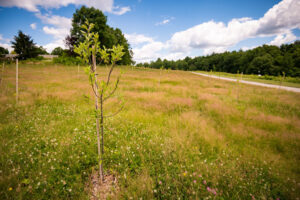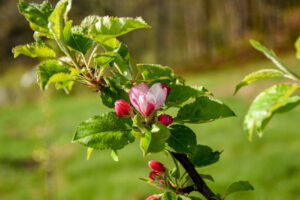By Liz Nye, New England Botanic Garden Staff
September 2023
Apple season is in full swing, but visitors won’t find any growing at the Garden—at least not yet. This fall marks four years since the Garden cut down its historic apple orchard, razing the mature trees in order to save its rare collection of heirloom apples from a devasting plant disease called fire blight. The young apple trees that today’s visitors see standing in the old orchard’s place are still in their infancy, growing slowly but surely. Last May, some even had their first blossoms. 
Eventually, the Garden’s Frank L. Harrington Sr. Orchard will again give people the opportunity to taste uncommon apples like the ‘Westfield Seek No Further,’ ‘Yellow Bellflower,’ and over one hundred others, some that were first cultivated as far back as the seventeenth century. In the meantime, work to ensure the success of the 268 replanted trees continues. Some of that work is now taking shape through academic partnerships.
Over the summer, the orchard was visited by researchers from Washington State University’s Apple Genome Project. The project aims to create a genetic fingerprint of every apple on the planet. The Garden’s collection, begun during the Great Depression by Worcester County Horticultural Society member Stearns Lothrop Davenport, contains 30 to 40 varieties that are exceptionally rare and so far, genetically unmapped.
“Heirloom crops chronicle a region’s history,” says Mark Richardson, director of horticulture at the Garden. “If heirloom varieties are lost — as might have happened with our orchard — with them could go any undiscovered genetic traits, like novel resistance to drought, pests, and diseases, that might benefit tree breeding research programs in the future,” he says. This is especially important in the age of climate change.
Fire blight, the disease that precipitated the 2019 orchard restoration, is accelerated by climate change. Caused by the bacteria Erwinia amylovora, fire blight, as those who have followed the orchard’s restoration journey will know, affects plants in the rose family like apples and cherries. It spreads in rainy, warm weather when air temperatures are above 75 degrees Fahrenheit. Carried on the bodies of honeybees, the bacteria can move quickly from tree to tree when apple blossoms are open.
“Plants have many different defenses to diseases, but diseases figure out mechanisms to get past those defenses and into plant tissue. Entering a plant’s vascular system through the flower is pretty ingenious,” Mark says. The effect is quickly observable. Fire blight infected trees look burned or charred. Eventually they die. While fire blight sounds dramatic, and it is, it was once only a minor concern because while apple blossoms are open in May, conditions were rarely warm and wet enough in New England to facilitate the spread of the bacteria.
Human-caused climate change means warmer springs, a trend expected to continue with the burning of fossil fuels. Since 2010, when the Garden first recorded fire blight in the orchard, the region has more often experienced springtime temperature and precipitation conditions just right for the disease to spread.
“Knowledge of our apples’ rarity makes protecting them from the complex challenges ahead all the more important,” Mark says.
 With the help of apple expert and founder of Fedco Trees, John Bunker, scionwood from each of the original orchard’s trees was collected and grafted onto fire blight resistant root stocks identified in the industry as M111, G890, and Antonovka. “This is an important defense,” Mark says, “but it’s not foolproof.” For this reason, the Garden will continue to closely monitor for presence of fire blight and follow a careful preventative integrated pest management program to keep it at bay. Garden volunteer and horticulturist, Leslie Duthie, works in the orchard each week, assessing the trees, conducting general orchard maintenance, and keeping notes on tree conditions. “Having someone with horticultural expertise working so closely and so consistently with the trees is one of our best defenses,” Mark says.
With the help of apple expert and founder of Fedco Trees, John Bunker, scionwood from each of the original orchard’s trees was collected and grafted onto fire blight resistant root stocks identified in the industry as M111, G890, and Antonovka. “This is an important defense,” Mark says, “but it’s not foolproof.” For this reason, the Garden will continue to closely monitor for presence of fire blight and follow a careful preventative integrated pest management program to keep it at bay. Garden volunteer and horticulturist, Leslie Duthie, works in the orchard each week, assessing the trees, conducting general orchard maintenance, and keeping notes on tree conditions. “Having someone with horticultural expertise working so closely and so consistently with the trees is one of our best defenses,” Mark says.
As part of the Apple Genome Project, researchers will use leaf samples collected on their visit to the Garden to conduct DNA analysis. Some of the varieties will undergo more extensive analysis to establish their pedigree, or their relationship to other known apple varieties. These and other steps are important examples of how preservation orchards can help facilitate research and identification of unknown apple varieties.
Before the onset of fire blight in 2010, the Garden ran a scionwood distribution program. Requests for scionwood came from all fifty states and even other countries. Who knows where other ‘Hightop Sweet,’ ‘Pumpkin Russett,’ and ‘Fall Harvey’ apples may be growing today. Mark hopes that one day in the not-too-distant future, in addition to sampling the apples, the Garden will also be able to start distributing scions to interested growers again.
“Having the only representative of a variety is dangerous,” Mark explains. The Garden’s apples will truly be safeguarded when the collection is shared. “A dispersed conservation orchard is the best protection of all,” Mark says.
Liz Nye is the Public Relations Manager at New England Botanic Garden. She holds a master’s degree in science writing from Johns Hopkins University and enjoys learning about and writing about all things plants.
Orchard Restoration Timeline
- SPRING 2010: Fire blight discovered in the orchard; Scionwood distribution program halted
- 2011 – 2018: Treatments, including injectable antibiotics, attempted
- WINTER 2019: Scionwood collection and grafting begins to propagate new trees
- FALL 2019: The old orchard of diseased trees is razed
- 2019 – 2020: Grafted trees grow in a nursery under the care of John Bunker, expert orchardist and founder of Fedco Trees in Maine
- SPRING 2021: The orchard is replanted larger than before with over 268 trees
- SUMMER 2022: Drip irrigation is installed to efficiently deliver water to each tree
- SPRING 2023: The first apple blossoms appear on a handful of trees
- SUMMER 2023: DNA collected for Washington State University’s Apple Genome Project
